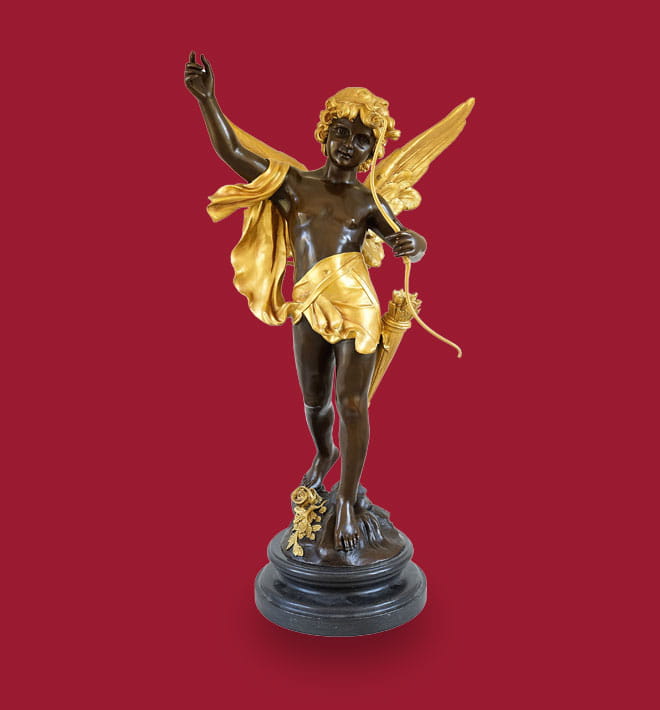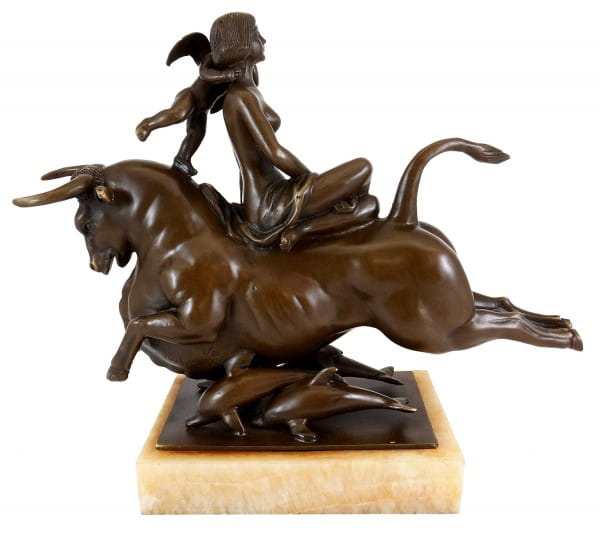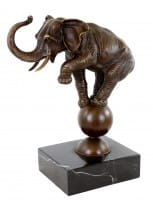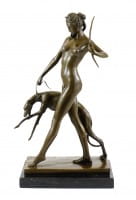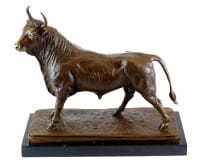€999.00 *
Prices incl. VAT, free shipping worldwide
Ready to ship today,
Delivery time appr. 3-6 workdays










An Art Deco Odyssey: The Flight of the Europa (1925) – Signed by Paul Manship In this sublime... more
Product description
"Art Deco - The Flight of Europa (1925) - Paul Manship Artist"
| Weight | 5,3 kg |
An Art Deco Odyssey: The Flight of the Europa (1925) – Signed by Paul Manship
In this sublime Art Deco masterpiece, limited to 20 pieces, the ancient myth of Europa is brought to life through gleaming bronze and streamlined forms. The young maiden leans forward on the charging bull, her gaze raised as if already sensing distant shores. Below her, dolphins breach the sea's surface, their curved backs echoing the bull's muscular hips. Above, the winged figure of Cupid supports Europa's shoulder, lending the scene a playful intimacy. Every line flows with dynamic dynamism, transforming a legendary elopement into an emblem of modern elegance.
A Moment, Cast in 1925
Paul Manship conceived and completed "The Flight of the Europa" in the spring of 1925, while his New York studio was bustling with the hustle and bustle of the Art Deco era. The initial clay model was approved by Manship's keen eye for classical harmony and then entrusted to the skilled artisans of the Roman Bronze Works for lost-wax casting. Each foundry team carefully chiseled the cooled bronze, refining the textures of the bull's smooth skin and the softly folded robes of the Virgin. At its unveiling that same year, the piece captivated collectors and critics alike with its fusion of mythical narrative and contemporary style.
The Sculptor's Transatlantic Journey
Paul Manship, born on December 25, 1885, in Saint Paul, demonstrated a distinct talent for clay modeling as a young teenager. After training at the Pennsylvania Academy of the Fine Arts, he received a scholarship to the American Academy in Rome, where he absorbed the grandeur of ancient sculpture and the flowing geometries of Renaissance fountains. After returning to the United States in 1917, he became a leading figure in the artistic community and was celebrated for his blending of classical motifs with the elegant language of modernism. His works adorned public squares and gallery walls alike, shaping a new formal language that connected past and present.
Slender Grace and Poetic Power
What distinguishes this Paul Manship sculpture is its simple lines. The taut muscles of the bull and the gentle curves of the damsel share the same clarity of form, as if carved from a single mythical block. Manship's signature—"Paul Manship"—appears discreetly on the base—a subtle mark on a work of overwhelming grandeur. The dolphins below are not mere ornamentation, but underscore the theme of transition from sea to land, from the mortal realm to divine favor. Light dances across the polished surfaces, illuminating subtle changes in the silhouette and inviting the viewer to trace Europa's journey, even as time stands still.
A Dialogue Between Eras
In 1925, the world fluctuated between upheaval and renewal. Art Deco, with its emphasis on progress and luxury, corresponded to a collective longing for beauty amidst modern complexity. In "The Flight of Europa," Manship embraced this spirit, transforming an ancient story into a vision of sovereign ascension. The sculpture's pyramidal silhouette—dolphins at the base, bull and maiden at the top—reflects the geometric rigor advocated by contemporary architects and designers. Yet the work never feels distant or cold; the delicate interplay of Europa and Cupid ensures that human emotions remain at the center.
Enduring elegance, eternal appeal
Almost a century after its creation, this Art Deco work, "The Flight of Europa" (1925), stands as a testament to Paul Manship's singular vision. Whether displayed in a grand foyer or a contemplative gallery, it commands attention with its narrative depth and refined craftsmanship. Each view reveals new nuances: the curve of the bull's flank, the tilt of Europa's chin, the delicate curve of the dolphin's back. Myth and modernity merge in this masterpiece, buoyed by the unstoppable power of the imagination.
In this sublime Art Deco masterpiece, limited to 20 pieces, the ancient myth of Europa is brought to life through gleaming bronze and streamlined forms. The young maiden leans forward on the charging bull, her gaze raised as if already sensing distant shores. Below her, dolphins breach the sea's surface, their curved backs echoing the bull's muscular hips. Above, the winged figure of Cupid supports Europa's shoulder, lending the scene a playful intimacy. Every line flows with dynamic dynamism, transforming a legendary elopement into an emblem of modern elegance.
A Moment, Cast in 1925
Paul Manship conceived and completed "The Flight of the Europa" in the spring of 1925, while his New York studio was bustling with the hustle and bustle of the Art Deco era. The initial clay model was approved by Manship's keen eye for classical harmony and then entrusted to the skilled artisans of the Roman Bronze Works for lost-wax casting. Each foundry team carefully chiseled the cooled bronze, refining the textures of the bull's smooth skin and the softly folded robes of the Virgin. At its unveiling that same year, the piece captivated collectors and critics alike with its fusion of mythical narrative and contemporary style.
The Sculptor's Transatlantic Journey
Paul Manship, born on December 25, 1885, in Saint Paul, demonstrated a distinct talent for clay modeling as a young teenager. After training at the Pennsylvania Academy of the Fine Arts, he received a scholarship to the American Academy in Rome, where he absorbed the grandeur of ancient sculpture and the flowing geometries of Renaissance fountains. After returning to the United States in 1917, he became a leading figure in the artistic community and was celebrated for his blending of classical motifs with the elegant language of modernism. His works adorned public squares and gallery walls alike, shaping a new formal language that connected past and present.
Slender Grace and Poetic Power
What distinguishes this Paul Manship sculpture is its simple lines. The taut muscles of the bull and the gentle curves of the damsel share the same clarity of form, as if carved from a single mythical block. Manship's signature—"Paul Manship"—appears discreetly on the base—a subtle mark on a work of overwhelming grandeur. The dolphins below are not mere ornamentation, but underscore the theme of transition from sea to land, from the mortal realm to divine favor. Light dances across the polished surfaces, illuminating subtle changes in the silhouette and inviting the viewer to trace Europa's journey, even as time stands still.
A Dialogue Between Eras
In 1925, the world fluctuated between upheaval and renewal. Art Deco, with its emphasis on progress and luxury, corresponded to a collective longing for beauty amidst modern complexity. In "The Flight of Europa," Manship embraced this spirit, transforming an ancient story into a vision of sovereign ascension. The sculpture's pyramidal silhouette—dolphins at the base, bull and maiden at the top—reflects the geometric rigor advocated by contemporary architects and designers. Yet the work never feels distant or cold; the delicate interplay of Europa and Cupid ensures that human emotions remain at the center.
Enduring elegance, eternal appeal
Almost a century after its creation, this Art Deco work, "The Flight of Europa" (1925), stands as a testament to Paul Manship's singular vision. Whether displayed in a grand foyer or a contemplative gallery, it commands attention with its narrative depth and refined craftsmanship. Each view reveals new nuances: the curve of the bull's flank, the tilt of Europa's chin, the delicate curve of the dolphin's back. Myth and modernity merge in this masterpiece, buoyed by the unstoppable power of the imagination.
Height: 25 cm
Width: 29 cm
Depth: 12 cm
Weight: 5,3 kg
100% Bronze
Related links to "Art Deco - The Flight of Europa (1925) - Paul Manship Artist"
Read, write and discuss reviews... more
Customer evaluation for "Art Deco - The Flight of Europa (1925) - Paul Manship Artist"
Write an evaluation
Evaluations will be activated after verification.
Our advantages
free shipping
Worldwide free shipping
14 days money back
You can cancel your order
within 14 days
secure payment services
Paypal, Master Card, Visa, American Express and more
NEW
NEW
NEW

